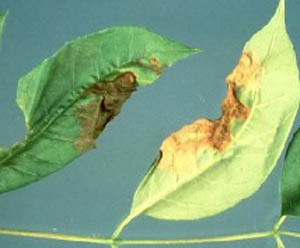Ash Anthracnose | |
|---|---|
| May 16, 2006 | |
|
Sycamore anthracnose was discussed in issue no. 3 of this newsletter, with a brief reference to other anthracnose diseases of shade trees. We have had reports in the past week of ash anthracnose. Morton Arboretum staff reports many telephone inquiries the past week concerning ash anthracnose. They report that the disease in the Chicago area has been severe enough to cause quite a bit of leaf drop. Common questions by homeowners focus on whether their trees are dying and what action can be taken. Ash anthracnose appears at about the same time as spring frost damage. Symptoms are similar as well. Look at other trees and shrubs in the area. Frost is likely to affect many species in the area, not just the ash trees. Ash anthracnose affects ash species and has been reported on Chinese fringe tree (Chionanthus), but it does not infect other tree and shrub species. Ash anthracnose tends to be worse at the bottom of the tree, where the canopy stays wet longer. Symptoms include water-soaked spots that spread and turn green–brown. As the tissues dry, the lesions turn tan. There may be some small (quarter-inch) spots, but usually the dead tissue appears as blotches that spread from the edge toward the midrib of a leaflet, as shown in image 060501.  The fungus can also infect the leaf petioles. In some years, we see leaf drop with no apparent infection of the leaf blades. Closer inspection usually reveals anthracnose on the petioles. The fungus can also infect the leaf petioles. In some years, we see leaf drop with no apparent infection of the leaf blades. Closer inspection usually reveals anthracnose on the petioles. Will ash anthracnose kill my tree? No. This disease infects newly emerging leaves in cool, wet weather. The environment favors the fungus, and leaves are succulent and susceptible to infection. If the next flush of leaves emerges in warmer or drier weather, infection is unlikely. We generally see ash anthracnose in midspring. Leaf drop may follow, but ash trees quickly develop new leaves as temperatures rise. The disease may contribute to tree stress, but it is not known to kill trees. What can I do to help the tree? Provide water in periods of drought, possibly mark your calendar to fertilize in the fall, and otherwise follow sound horticultural practices. One thing I would avoid is the use of fungicides. Such chemicals protect new growth from infection, but the next flush of growth is unlikely to be infected. For more information, consult Report on Plant Disease, no. 621, “Anthracnose Diseases of Shade Trees.” This report is available in Extension offices or on the Web at http://www.ag.uiuc.edu/%7Evista/horticul.htm. |